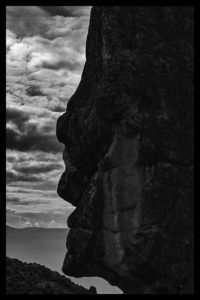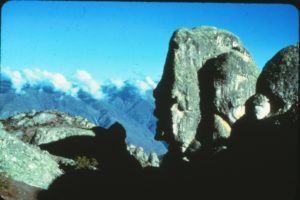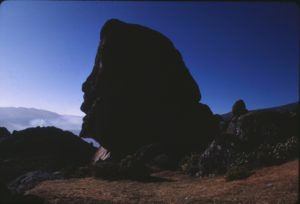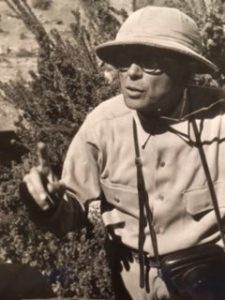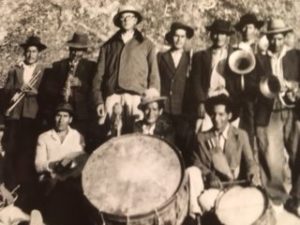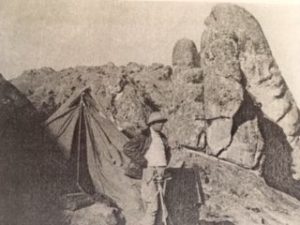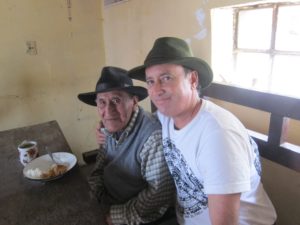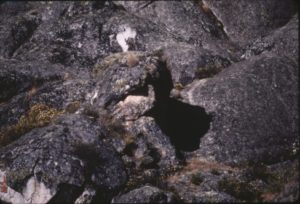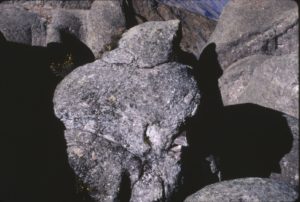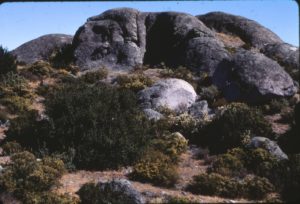The modern discovery of Marcahuasi was not fortuitous, but chance did play a part. Credit goes to Daniel Ruzo, who discovered Marcahuasi in 1952. Daniel had been interested in megalithic cultures since his youth, therefore he had an open mind which could accept the information he received, while others may have ignored it.
In February 1952 a close friend of Daniel’s, Enrique Dammert, made a present to him of a photograph taken in 1935 by Kuroki Riva. Based on what my father told me years later, this gentleman spent much of his time traveling around Peru, and who knows where else, taking pictures of anything that looked, to him, unusual. Dammert’s dedicatory, written on the back of the photo (shown in Figure 1), which now hangs on a wall of my study, reads thus:
“ I transfer to Don Daniel Ruzo this picture taken by my great friend Kuroki Riva, not because I do not like it, but rather because in Los Angeles (where my father had his country house near Lima) it will be more highly appreciated and reach further. In any case, this marvel will remain among the madmen of this valley (these were my father, Dammert and Asin, the latter lived in a railway car he had lifted up the side of a mountain). Until its truth be deciphered and Don Daniel learn to photograph rocks.”
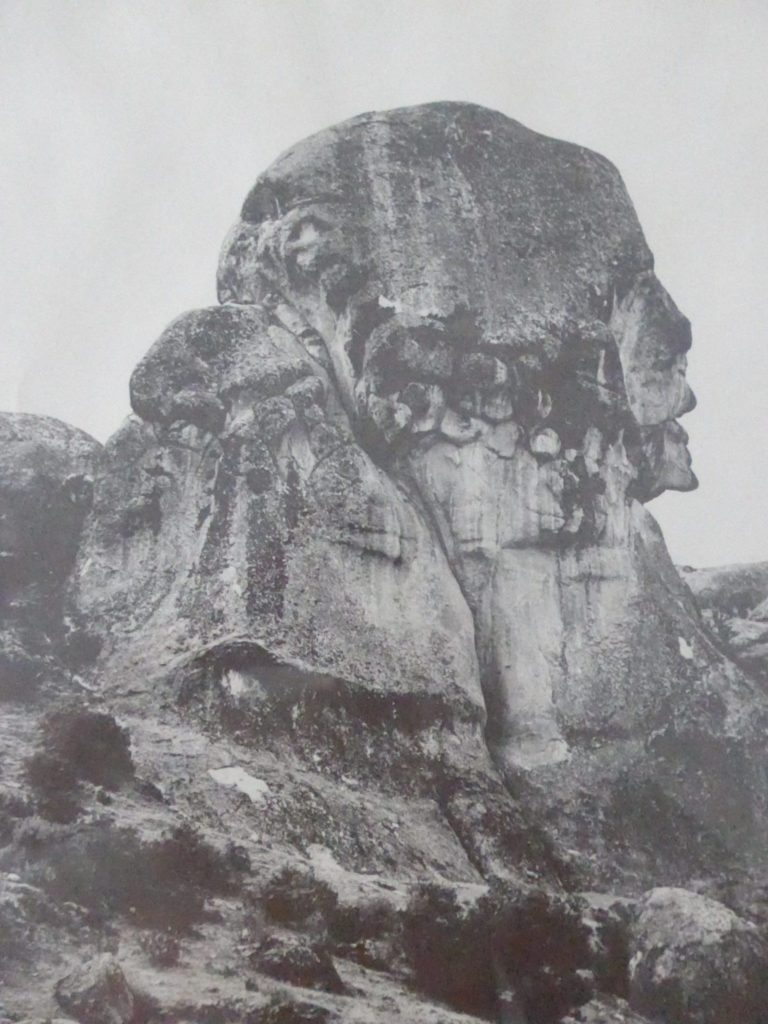
Ruzo definitely learned how to photograph rocks. Riva’s picture consisted of an exceptional stone structure (Figures 1 and 2) seemingly carved with many anthropomorphic figures. Because he had always been interested in ancient cultures, he considered the possible meaning of such a magnificent sculpture. He organized an expedition which took him to a small village in the central Andes, San Pedro de Casta. Ruzo describes this first journey in his book Marcahuasi: The Fantastic History of a Discovery:
“During the month of August we journeyed up the valley of Santa Eulalia to the bridge at Autisha and managed to establish contact with a group of men descending from Casta, a village of approximately one thousand inhabitants at 3,200 meters above sea level. The only trail that could take us to the site where the photograph had been taken started near this village. The people there called the gigantic rock “Head of the Inca”, though obviously it had no relationship to the Incas. The men we had met were Inocencio Obispo, Justiliano Rojas and Manuel Olivares. The latter, sometimes together with another villager, Miguel Bautista, accompanied me throughout the many expeditions I conducted in the following nine years. They had promised to have horses available on the following September 1 and on that day we returned to Autisha and initiated our first climb to the high plateau, whose ancient name is lost, but which since the Inca invasion of this region has been known as Marcahuasi. This name is Quechua, that is Huanca, as are all the names applied to the topography of the central region of Peru. It may be translated as ‘the place of dwellings”, possibly because of the numerous soldiers’ barracks to be found there.
As soon as we had arrived to the top of the plateau we sighted an exceptional stone, twenty-five meters high on the Western side and twenty on the opposite side (see Figures 1 and 2 in the section Research of this website). It may represent a monument to humanity, erected in very ancient times, since on it one can see sculptures of human heads and faces from many different ethnic groups. The sculptors must have worked this rock in times so ancient that its name has been forgotten and it is now referred to by the old people in the village as Peca Gasha, or “the head in the alley”, which corresponds to its location at the entrance to the plateau.”
In the following nine years Ruzo conducted a thorough photographic study of Marcahuasi. His work is now stored in the ECYART archives. His original work is illustrated in Figures 2a-c, three different views of the Peca Gasha from the West. Three recent photos taken from the East are shown in Figures 2d-f.
Since Daniel Ruzo’s 1952 discovery of Marcahuasi, significant research has been done at the site, which you can read about on our Research Data page and on our Ongoing Research page.
Daniel Ruzo and his first campsite may be seen in Figures 3-5, and his friend and guide Manuel Olivares in Figures 6a and 6b, these photographs were taken by me many years later when Don Manuel was nearing ninety years of age.
A short time after Ruzo’s first expedition the people of Casta helped in the construction of a simple hut which served Ruzo through the years of his visits to the plateau and which continues to shelter visitors today (see Figure 7, photo courtesy of Alex Kornhuber).
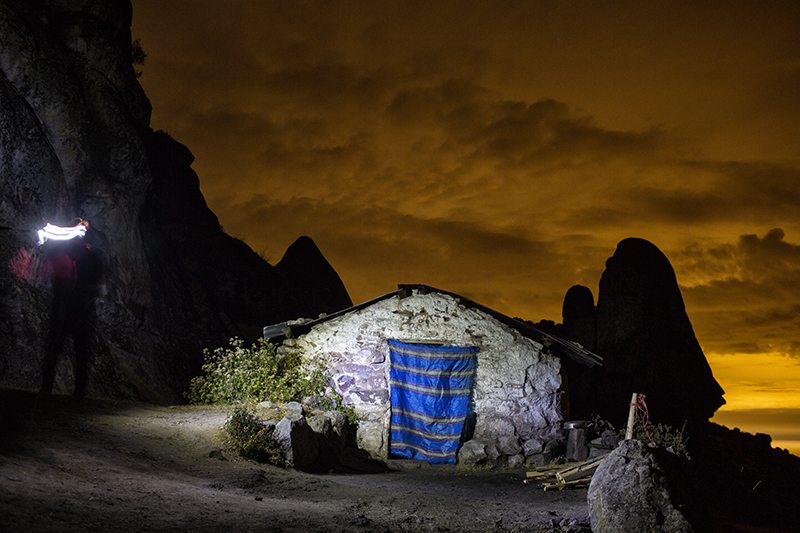
There must have been something very important that made these two men bond, because even today Don Manuel’s family maintains a very close relationship with Javier Ruzo, Daniel’s grandson, and with myself. My father died on the 21st of September, 1991 and Manuel Olivares on the same day in 2014.
In June 1954 Ruzo published the first report on Marcahuasi (The Masma Culture), based on a presentation he gave at the Military Academy of Peru. For the first time he referred to a human culture that may have disappeared long ago, perhaps after a great catastrophe. Years later he developed a chronological theory based on the displacement of the solar system along the ecliptic, a journey that takes the sun and its planets on an enormous spiral lasting 25,920 years, with each zodiac sector of 2,160 years (The Last Days of the Apocalypse). This culture would date from a period when the system changed from the sector Cancer to Gemini, more than eight thousand years ago. The next transition will be from our current sector Piscis to Aquarius in ~2,140 AD. He called the culture that had created the sculptures in Marcahuasi “Masma”, based on information he received from his friend and mentor, Pedro Astete. Astete’s words in relating a dream he had in Andahuaylas at the house of a friend, which was reputed to be haunted by a Nacaj (a malignant spirit):
“The dream was beginning to dissipate, but before it went completely I managed to distinguish the presence of certain beings dressed in ceremonial robes of black and white and heard the word Masma uttered.
I sought information about this name which sounded ancient to me, as if I had heard it in earlier times. No one could give me information about it, however most agreed that it could derive from an Indian name. Some years later, now back in Lima, three things happened almost simultaneously which allowed me to remember…”
The first of these three events was finding the word Masma in a Quechua dictionary with two meanings provided: a house of wide overhanging eaves or a clay container, similar to the pakarinas, used for burials. In a description of the departments of Junin and Ayacucho, in the central Andes of Peru, by Dr Luis Carranza, Astete found the word Masma as the name of a hamlet or a ruin near Jauja (an old city of the Huancas). The third instance happened while Astete was leafing through the Bible where the name Masma struck him again, now as the name of the fifth son of Ismael (Genesis XXV, 14). As we now know designations of the patriarchs and their children often represented cultures and ethnic groups.
For the Ruzos the name Masma has an even deeper meaning. Our family emigrated to the Americas from a village called Lea near Lugo, in the Spanish region of Galicia. The house of the Ruzos still stands, abandoned for centuries, its lower story partly covered in silt deposited by the river Ruzo which originates nearby. A few leagues from Lea, a little beyond Mondonedo (the county seat), this river passes through San Andres de Masma and there takes that name. It’s a coincidence that seems incredible, but both my father and I have been to these places and I can confirm the veracity of this story. My father named the Marcahuasi culture Masma before having been to Galicia.
Ruzo discovered a great number and variety of sculptures on the plateau, many representing human heads and the faces of personages whose identity is lost in time, as well as various animals. Some recent photographs of these are given in Figure 8-16, as well as in the Marcahuasi Research Section of this website. Through the years in which he studied Marcahuasi he looked unsuccessfully for relationships between the most important structures. The technology available in the 1950s did not provide the information we have now obtained using geosynchronous satellites (GPS) (see Table 1 in the Research section of this website). Furthermore, Ruzo did not consider in his work other minor structures and smaller rocks, whose importance we have now established and have designated “markers” (see the Research section).
Daniel Ruzo’s work has been presented in numerous articles in magazines and in History and Discovery channel programs over the years.
If you’re interested in being a part of the Marcahuasi research, please reach out.



